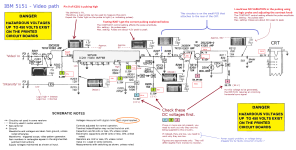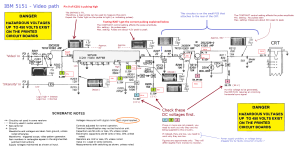VERAULT
Veteran Member
So I bought a 5170 AT recently and the unit is "short city" Everything in the unit and cards has shorts.
The IBM 5151 monitor was DOA as well. I thought I had it down to the TR24 MJ2955 PNP Power Transistor but that was a red herring. I followed the SAMS 5151 VDU troubleshooting and got to the point where it wanted to check:
"Check the sources that are developed from Transformer T502. Check for 56.8V at the cathode of Diode D503 and 546V at the cathode of Diode D505.
I get 14.8V at the cathode of D505 and I get 0.38V at the cathode of D503
I am getting 0.33 OHMS on the Horizontal Coil
and I am getting 4.11 OHMs on the Vertical coil
I am getting 1.0 OHMS on the "RED" TR801 power transformer coil
I am getting 17.1 OHMs on the TR801 Coil "BLACK" winding
The heater is glowing, I get no high voltage, no high pitched squeal. I get no raster of any kind.
Could use some help on this.
The IBM 5151 monitor was DOA as well. I thought I had it down to the TR24 MJ2955 PNP Power Transistor but that was a red herring. I followed the SAMS 5151 VDU troubleshooting and got to the point where it wanted to check:
"Check the sources that are developed from Transformer T502. Check for 56.8V at the cathode of Diode D503 and 546V at the cathode of Diode D505.
I get 14.8V at the cathode of D505 and I get 0.38V at the cathode of D503
I am getting 0.33 OHMS on the Horizontal Coil
and I am getting 4.11 OHMs on the Vertical coil
I am getting 1.0 OHMS on the "RED" TR801 power transformer coil
I am getting 17.1 OHMs on the TR801 Coil "BLACK" winding
The heater is glowing, I get no high voltage, no high pitched squeal. I get no raster of any kind.
Could use some help on this.
Last edited:


